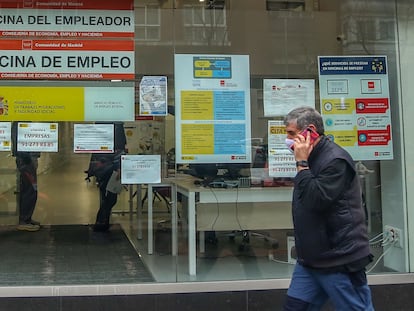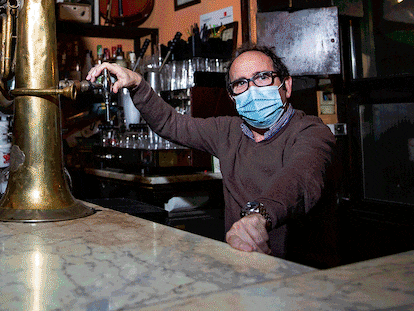Spain’s tourism industry feeling the loss of British visitors
The number of tourists from the United Kingdom fell 82% in 2020 due to the coronavirus pandemic, with the Balearic Islands hardest hit by the drop
The Spanish tourism industry is feeling the loss of British visitors, whose numbers plummeted 82% in 2020 from the previous year, according to figures released Wednesday by the National Statistics Institute (INE). The drop is blamed on the coronavirus pandemic, which led to strict restrictions on travel, quarantine rules and the closure of bars and restaurants. Most of Spain is used to receiving tourists from the United Kingdom, be it over summer or in the low season. The drop has hit the Canary and Balearic islands especially hard, as both archipelagos are highly dependent on international tourism and air connectivity.
But it is not just visitors from the UK that are being missed. Spain’s tourism industry is also feeling the loss of tourists from Germany, France, Scandinavian countries, the Netherlands and Italy. The drop in British tourists, however, has been the greatest, both in terms of the number of arrivals and in expenditure. This fall – together with the decline in German tourists – is having a big impact on Spain’s islands.
In the Balearic Islands, the drop in British tourists has been dramatic. Just 223,000 travelers from the UK visited the archipelago in 2020, compared to 3.7 million in 2019 – a fall of 93%. The decline in visitors from Britain, which is the second-largest source country of tourism to Spain, has been keenly felt in popular tourist destinations like Calvià in Mallorca island and Sant Antoni in Ibiza, with many businesses in these areas forced to close.
The numbers of tourists began to nosedive from mid-July, when the British government of Boris Johnson recommended against travel to Spain and imposed a 14-day quarantine on visitors returning from the country in a bid to slow the spread of the coronavirus. The fall in German visitors compounded the loss. Last year, only 720,459 tourists from Germany visited the Balearic Islands, a drop of 84% on 2019 figures. In total, spending by all international tourists in the region plummeted from €14.8 billion in 2019 to just €1.8 billion, a fall of 87%. Indeed, the Balearic Islands is the Spanish region that has seen the biggest drop in all international visitors, with the numbers of foreign tourists from 13.6 million in 2019 to just 1.7 million last year, a drop of 87%.
“Devastating impact”
“The quarantine [on visitors returning from Spain to the UK] was a deathblow. Instead of holding on a little longer, hotels had to gradually close because the impact of the fall in British tourists was devastating. In October, all the facilities were closed,” says Mauricio Carballeda, the president of the Palmanova-Magaluf Hoteliers Association in the Balearic Islands. Hotel occupancy last summer ranged between 30% and 40% – in a normal year, more than 90% of rooms are booked. It was domestic tourism that helped compensate for this loss, with many establishments surviving thanks to visitors from Spain.

The resort town of Magaluf in Mallorca almost exclusively depends on tourists from the UK, in particular, young British visitors looking for a vibrant nightlife. In February 2020, the regional government of the Balearic Islands approved regulation to crack down on so-called “booze tourism,” where visitors are encouraged to binge-drink alcohol. The rules also targeted so-called balconing, a term that refers to usually inebriated tourists jumping from balcony to balcony in their hotels, or attempting to launch themselves from great heights into swimming pools. But with nightclubs closed since last August due to coronavirus restrictions, there has been no occasion to use this law. Magaluf, which is brimming with bars and restaurants, has become an empty backdrop, visited only by sporadic groups of foreign youths, with its beaches reclaimed by local residents.
The outlook for 2021 is just as uncertain, says Carballeda, who explains that everything depends on how the pandemic evolves over the next few months, whether there are new travel rules, and if a safe travel corridor can be opened between the UK and the Balearic Islands. “Vaccination will be another factor,” he says. “The British are going at a strong rate and we will have to see what level of immunization there is here. The recovery will begin in summer, not before.” Adding to the uncertainty is the impact of Brexit and fear of contagion from the new strains of the coronavirus.
Blow to Canary Islands
In the Canary Islands, the situation in 2020 was somewhat different. The number of international tourists to the archipelago fell 71%, significantly less than in the Balearic Islands. This is partly due to the fact that the region was able to receive visitors last winter, which is its high season. However, its current high season has also coincided with the peak of the third coronavirus wave in Spain and Europe. “January 2021 has been worse than what happened in 2020,” says José María Mañaricúa, the president of Las Palmas hotel association. “All our main markets are closed and have toughened restrictions, and the new strain detected in Britain has been the final blow.”

The devastating impact of the coronavirus pandemic on the Canary Islands’ tourism industry is reflected in the INE data. In the first six months of 2020, the number of British visitors to the archipelago fell 88% – from 2.5 million in 2019 to just under 309,000. It was a hard blow to the sector, which received 4.94 million tourists from the UK in 2019. This represented nearly two thirds of the 15.1 million international visitors the region received that year. But it is not only visitors from Britain that fell in 2020. The number of foreign tourists to the Canary Islands plummeted to 4.8 million last year, a 71% drop from 2019, when 16.8 million international visitors came to the region.
The head of the Canary Islands tourism department, Yaiza Castilla, admitted on Wednesday that the winter high season was a lost cause as Spain and the main markets in Europe were experiencing “one of the worst moments of the pandemic.” Castilla also said she was disappointed with the central Tourism Ministry, which announced a special plan for the archipelago in October. Despite this, Castilla says “no aid has come.”
International visitors fall to record lows
The coronavirus pandemic has taken a toll on all of Spain’s tourism industry. According to the INE, Spain received a historic low of just 18.96 million foreign visitors in 2020. This represents a fall of 77% on figures from 2019, when the country welcomed 83.5 million international tourists, setting a new record high for the seventh year in a row.
Tourist expenditure also fell dramatically last year. Visitors spent €19.7 billion in 2020, down from €91.9 billion in 2019, a drop of 78.5%. This has had a significant effect on the Spanish economy. In 2019, the tourism industry accounted for 12.4% of Spain’s gross domestic product (GDP). Last year, it accounted for just 4%.
Following the Balearic Islands, the regions hardest hit by the fall in international visitors were Catalonia (a drop of 80%), Madrid (77.7%), Andalusia (77.5%) and the Valencia region (73.2%).
English version by Melissa Kitson.
Tu suscripción se está usando en otro dispositivo
¿Quieres añadir otro usuario a tu suscripción?
Si continúas leyendo en este dispositivo, no se podrá leer en el otro.
FlechaTu suscripción se está usando en otro dispositivo y solo puedes acceder a EL PAÍS desde un dispositivo a la vez.
Si quieres compartir tu cuenta, cambia tu suscripción a la modalidad Premium, así podrás añadir otro usuario. Cada uno accederá con su propia cuenta de email, lo que os permitirá personalizar vuestra experiencia en EL PAÍS.
¿Tienes una suscripción de empresa? Accede aquí para contratar más cuentas.
En el caso de no saber quién está usando tu cuenta, te recomendamos cambiar tu contraseña aquí.
Si decides continuar compartiendo tu cuenta, este mensaje se mostrará en tu dispositivo y en el de la otra persona que está usando tu cuenta de forma indefinida, afectando a tu experiencia de lectura. Puedes consultar aquí los términos y condiciones de la suscripción digital.
More information
Últimas noticias
Maduro pleads not guilty before the federal court in New York: ‘I am still the president of Venezuela’
A new test can detect Alzheimer’s from a finger prick
UN team enters Sudanese city of El Fasher after paramilitary massacre: ‘It’s like a ghost town’
A recipe for resistance: Indigenous peoples politicize their struggles from the kitchen
Most viewed
- Gilles Lipovetsky: ‘If you want to live better and fall in love, take Prozac, don’t look to philosophy’
- Alain Aspect, Nobel laureate in physics: ‘Einstein was so smart that he would have had to recognize quantum entanglement’
- Alvin Hellerstein, a 92-year-old judge appointed by Bill Clinton, to preside over Maduro’s trial in New York
- Why oil has been at the center of Venezuela-US conflicts for decades
- Maduro’s downfall puts China’s relationship with Venezuela to the test










































